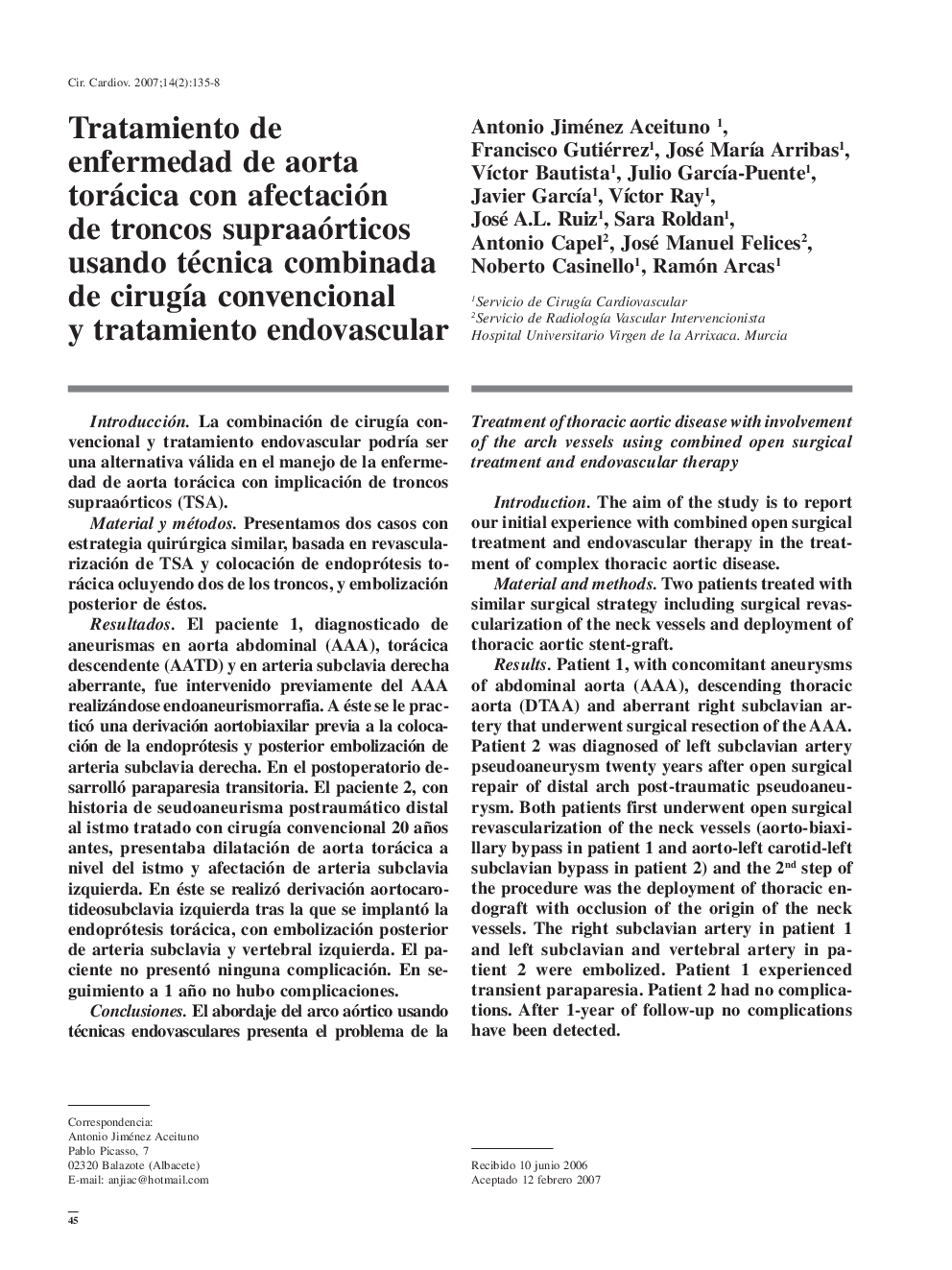| Article ID | Journal | Published Year | Pages | File Type |
|---|---|---|---|---|
| 2907917 | Cirugía Cardiovascular | 2007 | 4 Pages |
IntroducciónLa combinación de cirugía convencional y tratamiento endovascular podría ser una alternativa válida en el manejo de la enfermedad de aorta torácica con implicación de troncos supraaórticos (TSA).Material y métodosPresentamos dos casos con estrategia quirúrgica similar, basada en revascularización de TSA y colocación de endoprótesis torácica ocluyendo dos de los troncos, y embolización posterior de éstos.ResultadosEl paciente 1, diagnosticado de aneurismas en aorta abdominal (AAA), torácica descendente (AATD) y en arteria subclavia derecha aberrante, fue intervenido previamente del AAA realizándose endoaneurismorrafia. A éste se le practicó una derivación aortobiaxilar previa a la colocación de la endoprótesis y posterior embolización de arteria subclavia derecha. En el postoperatorio desarrolló paraparesia transitoria. El paciente 2, con historia de seudoaneurisma postraumático distal al istmo tratado con cirugía convencional 20 años antes, presentaba dilatación de aorta torácica a nivel del istmo y afectación de arteria subclavia izquierda. En éste se realizó derivación aortocarotideosubclavia izquierda tras la que se implantó la endoprótesis torácica, con embolización posterior de arteria subclavia y vertebral izquierda. El paciente no presentó ninguna complicación. En seguimiento a 1 año no hubo complicaciones.ConclusionesEl abordaje del arco aórtico usando técnicas endovasculares presenta el problema de la oclusión de TSA. El uso de derivaciones quirúrgicas hace posible esto. El abordaje combinado es aún una técnica nueva pero que podría ser una alternativa válida a la cirugía abierta de arco y aorta torácica descendente. Nuestra experiencia es satisfactoria, aunque no concluyente por tratarse sólo de dos casos.
IntroductionThe aim of the study is to report our initial experience with combined open surgical treatment and endovascular therapy in the treatment of complex thoracic aortic disease.Material and methodsTwo patients treated with similar surgical strategy including surgical revascularization of the neck vessels and deployment of thoracic aortic stent-graft.ResultsPatient 1, with concomitant aneurysms of abdominal aorta (AAA), descending thoracic aorta (DTAA) and aberrant right subclavian artery that underwent surgical resection of the AAA. Patient 2 was diagnosed of left subclavian artery pseudoaneurysm twenty years after open surgical repair of distal arch post-traumatic pseudoaneurysm. Both patients first underwent open surgical revascularization of the neck vessels (aorto-biaxillary bypass in patient 1 and aorto-left carotid-left subclavian bypass in patient 2) and the 2nd step of the procedure was the deployment of thoracic endograft with occlusion of the origin of the neck vessels. The right subclavian artery in patient 1 and left subclavian and vertebral artery in patient 2 were embolized. Patient 1 experienced transient paraparesia. Patient 2 had no complications. After 1-year of follow-up no complications have been detected.ConclusionsCombined surgical and endovascular approach to the aorta arch may represente an alternative to open surgery of the arch and descending thoracic aorta. Our satisfactory experience is too short as there are only two cases reported.
